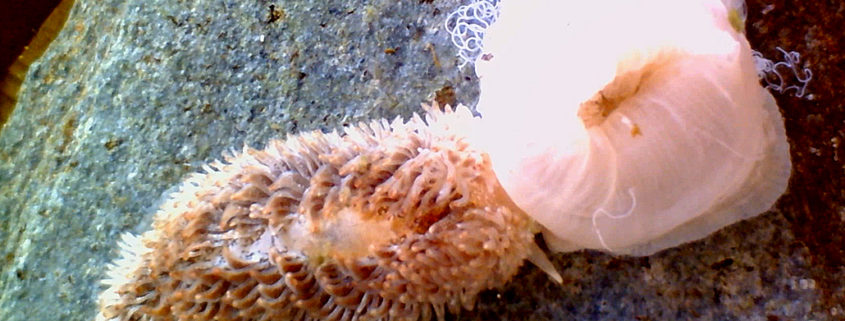Shag Mouse Nudibranch Author: Breyn Banks Common Names: Shag Mouse Nudibranch, Shag Rug Nudibranch, Shag Nudibranch. Scientific Name: Aeolida papillosa Size Range: 10 to 12 cm in length. Photographs by D. Young
Identification
Little is known about the Shag Mouse Nudibranch (Aeolida papillosa). They belongs to the group of soft bodied marine gastropods known as the nudibranchs. They range from 10 to 12 cm in size depending on what part of the world they live in and are known by many names such as The Shag Mouse Nudibranch, Shag Rug Nudibranch, or just simply the Shag Nudibranch. They get these names from the shag-esk ceratas running over its body. The certas themselves do not split down the centre or spread apart which is counter to a lot of other shaggy nudibranchs making them easily identifiable if you are looking for them.
Distribution
The shag rug nudibranch lives in the intertidal zones of the atlantic and pacific ocean. The deep water species which live in the pacific northwest live at depths of 500 meters deep, but some species have been found as deep as 900 meters. They are mainly found in the Circumboreal, the South of France, the South of Maryland, Argentina, the Falkland Islands, The Sea of Japan, Alaska, and Chile. The shagmouse nudibranch lives in many different habitats and parts of the world.
Food
The shag mouse nudibranchs known diet is very simple. They feed on various sea anemones. The shag mouse nudibranch has a very interesting defence system that goes with its simple diet. When they feed on the various anemones they store the preys stinging cells (cnidocytes) in its cerata for defence. They also will change colour based on the colour of food they ate much in the way that a flamingo is the same colour of the shrimp it eats.
Predators
The specific predators of the shag mouse nudibranch are unknown but if it is similar to other nudibranchs then crabs and sea stars would be among the most likely predators.
Reproduction
The shag mouse nudibranchs reproduces similar to other nudibranchs. They are hermaphroditic, containing gonads that produce both eggs and sperm. Individuals will transfer sperm and the eggs are laid in a gelatinous spiral.
References
Johnson, P.M & Willows, A.O.D, (1999) Defense in Sea Hares (Gastropoda, Opisthobranchia, Anaspidea): multiple layers of protection from egg to adult. Marine & Freshwater Behaviour & Physiology, 32: 147-180.
Hildering, J. & Miller, G., 2007 (Jul 10) Cadlina luteomarginata? being eaten by a seastar. [Message in] Sea Slug Forum.Australian Museum, Sydney. Available from http://www.seaslugforum.net/find/20125
The Reproductive Systems of the Nudibranchia (Gastropoda, Opisthobranchia): Comparative Histology and Ultrastructure of the Nidamental Glands with Aspects of Functional Morphology





Leave a Reply
Want to join the discussion?Feel free to contribute!